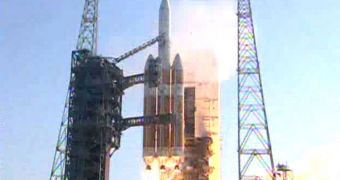Yesterday, June 29, the United States launched its newest spy satellite into orbit, aboard the most powerful rocket currently in operations worldwide. Takeoff occurred at 9:15 am EDT (1315 GMT), and saw the payload being successfully inserted into its transfer orbit.
The Delta IV Heavy delivery system took off from the Cape Canaveral Air Force Station's (CCAFS) Space Launch Complex 37B (SLC-37B), carrying the mission designation L-15. The launch was contracted by the US National Reconnaissance Office (NRO).
This is the official spy agency of the United States, and it operates a large number of satellites in various orbits around the planet. The specs and capabilities of these vehicles are classified, but judging by the recent donations the NRO made to NASA, they are extremely high-tech instruments.
According to officials, the newly-launched reconnaissance satellite is designated NROL-15. In order to deliver it to space, the Delta IV Heavy rocket had to be outfitted with a new generation of first stage engines, Pratt and Whitney Rocketdyne's RS-68A.
Representatives from the company say that these are the most powerful liquid hydrogen-fuel rocket motors ever developed, and that they are capable of generating a total of 702,000 pounds of thrust. They are significantly more efficient than previous generations of similar motors.
All versions of the Delta IV delivery system are designed and built by the United Launch Alliance (ULA), a long-term cooperative effort between the Boeing Company and Lockheed Martin Corp.
The technical specifications chart for the Delta IV Heavy vehicle indicates that the vehicle is capable of carrying up to 24 tons of cargo into low-Earth orbit (LEO) and 11 tons into a geosynchronous orbit (GEO). The rocket is around 72 meters (235 feet) tall.
The new mission took off just 9 days after the June 20 launch of the NROL-38 spy satellite, also on an ULA rocket. “Phew! 2 launches in 9 days. Who says things slow down in summer!” officials from the company said on Twitter after yesterday's launch, Space reports.
Another spy satellite launch is schedule to take place this August, on an ULA Atlas V delivery system. The rocket will take off from the Vandenberg Air Force Station (VAFB), in California.

 14 DAY TRIAL //
14 DAY TRIAL //